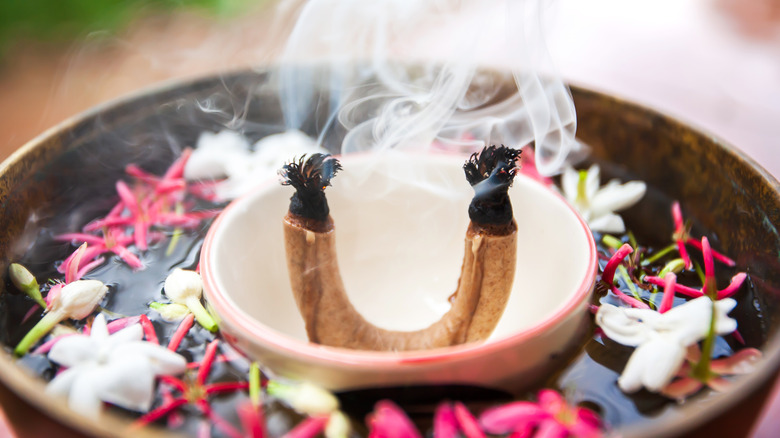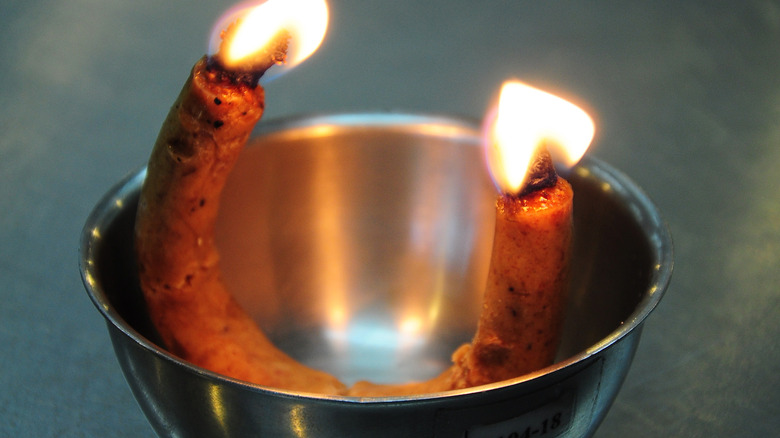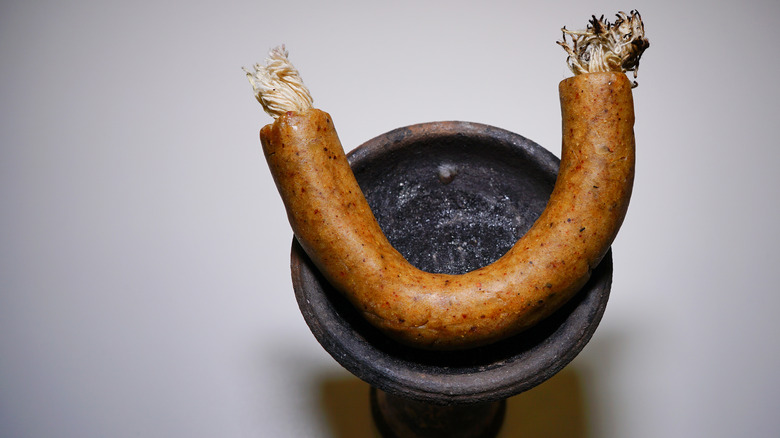Tian Op, The Candle That Perfumes Thai Desserts
There are candles for pure fragrance, ones for meditation, and others for aromatherapy, romance, or lighting a room when the power poofs out. But for cooking? Many Westerners, both professional chefs and home-kitchen cooks, are new to the concept of delicately perfumed desserts smoked by a lit candle. However, it's common in Thai cuisine, and it's called tian op.
Those who've experienced the exotic results of tian op describe the flavor as floral, sweet, and musky with hints of smoky caramel — but that can easily change based on the specific dessert and which aromatic scent the wick has been soaked in. The intensity and complexity of the fragrance of the dish also deepen the longer it's exposed to the smoke.
A tian op candle potentially works on many dessert recipes, but it really shines in Thai cookies and sweet desserts such as tub tim krob and a-lua, a creamy treat made with coconut milk. A popular recipe that's easy for any type of chef is salim, a coconut syrup-based treat made with mung-bean flour.
Whatever recipe you're exposing to the tian op experience, just plan enough time to monitor the smoky deliciousness as it builds over a period of time. The actual candle flames, two of them, extinguish themselves when deprived of oxygen, but it's still a smoldering heat source in your kitchen.
How tian op works
The shape of a tian op candle is the defining characteristic, primarily because it facilitates a double dose of smoky perfume. Picture a horseshoe or a letter C, and imagine lighting the two curved ends. Since tian op is a candle with beeswax wicks in each end, you can let them smoke for minutes or even hours.
Don't worry; the ingredients in your dessert don't get dripped by waxy globs, as the candle is strategically placed on a small plate, apart from the food, in a lidded bowl or saucepan. The smoke circulates within the container and permeates the dessert. You'll typically cook the dessert first, so the smoke infuses an already-formed dessert. However, some recipes call for smoking each ingredient separately before adding it to the dessert.
The fragrant essence imparted to the dessert comes from a specific or blended aromatic additive that's chosen by the candlemaker. Expect to find earthy, spicy, or floral options such as patchouli, ylang-ylang, frankincense, and even vanilla, which can reside in woodsmoke.
It's important to remember that tian op candles are designed specifically for flavoring food rather than scenting a room, but the sensory component affects the tastebuds since a high percentage of human taste comes from the sense of smell.
Tian op history and variations
Thailand is considered by many to be the origin country of tian op, with links to Thai royalty and palace cuisine. However, the practice likely predates its establishment in Thailand and other Asian countries. One theory is that it came from the Middle East via the infamous international Spice Route as Arabian spices and customs made their way into Southeast Asia.
The custom also has similarities with a culinary practice in North India in which ghee-style butter hits charcoal to smoke various curry dishes. But in traditional Thai cooking, tian op is strictly for desserts.
Generations of Thai chefs carry on the custom, evidenced by Thai cookbook author Nancie McDermott and her nod to tian op. However, the perfumed aroma from the tian op candle isn't for every dessert, particularly ones with their own defining aromas, such as the buttery smell and taste of shortbread or the fruitiness of berry pies.



